Mentioning a visit to Gyeongju immediately evokes tours of ancient sites, but the city is also identified with stunning natural landscapes. The harmonious blend of mountains, sea, lakes, and plains creates its own brand of charm.
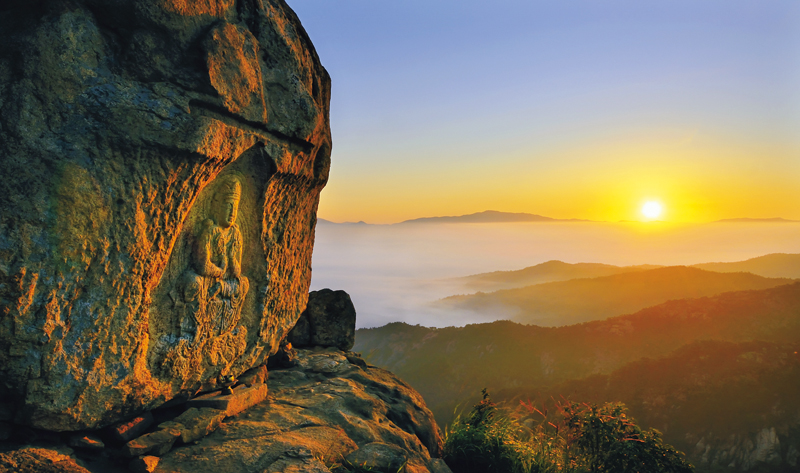
Located in the southern part of Gyeongju, Namsan comprises approximately forty valleys and ridges that extend from two main peaks at 468 m and 494 m above sea level. The area is famous for its beautiful natural landscapes and contains the highest concentration of Buddhist cultural heritage in South Korea.
© Gyeongju City, Photograph by Park Yeong-hui
“One cannot claim to have seen Gyeongju without seeing Namsan.” This saying points visitors southward from the city center to the symbolic mountain that embodies the spirit of the thousand-year Silla Kingdom. Numerous temples built on its slopes convey the reverence directed toward the mountain, an of worship for the Silla people.
Time has not robbed Namsan (Mt. Nam) of its special charm. Although many of the temples have disappeared, stone pagodas and Buddhist images carved into the rock faces still remain. Naturally, centuries of exposure to wind and rain have taken a toll, but cracks and worn surfaces make the ancient works appear more natural, merging with the mountain’s rocks and trees. Each with its own character and appearance, the numerous stone Buddhas and pagodas encountered along the hiking trails seem to generate a gentle energy despite being carved out of hard granite. This mysterious warmth might be the lingering echo of countless devotional touches by past worshippers.
EVERLASTING PINE SCENT
Namsan comprises forty valleys and ridges descending from two peaks: Geumobong (468 m) and Gowibong (494 m). Though not towering by mountaineering standards, it is characterized by majestic rock formations, and its numerous hiking trails boast points of interest at almost every bend.
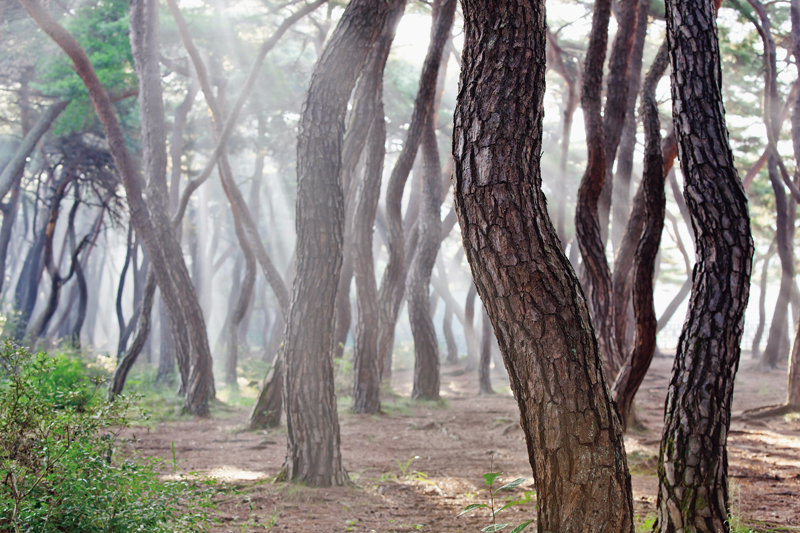
Nestled on the western slope of Namsan, Samneung Forest surrounds three royal tombs with its majestic pine trees. The twisting pines create an almost mystical landscape that draws photographers year-round, all hoping to capture the forest’s timeless atmosphere.
© gettyimagesKOREA
Those ascending Namsan do not move quickly. Their primary goal is not to reach the summit but to explore the mountain like an open-air museum, making frequent stops to examine the cultural treasures along the way. Around seven hundred relics can be found here, including three royal tombs from the Silla period, surrounded by thousands of pine trees. Since 80 percent of the mountain’s wooded area is covered by these evergreen trees, Namsan is draped in a canopy of green even in the depths of winter.
The mountain’s pine woodlots became widely known through the works of renowned Korean photographers like Kang Woon-gu and Bae Bien-u. What their lenses captured resembles traditional ink landscapes painted in free brushstrokes, where tree trunks extending in curves or straight lines intertwine, bathed with gentle sunlight filtering through or enveloped in the occasional soft mist.
Samneung Forest is one of Korea’s most beautiful pine groves. Located on the western slope of Namsan, this area features three royal tombs positioned side by side. Fittingly, Samneung means “three tombs.” The large mounds nestled among the pines appear to be naturally undulating hillocks with a welcoming aura, not the resting place of royalty.
Many visitors come to the forest in the early morning, drawn by the lingering dawn mist and the fresh pine fragrance. Here, people are often seen sitting beneath the pines or embracing tree trunks in long, contemplative interludes.
THE IDEAL PROMENADE
When spring arrives in Gyeongju, travelers make their way to Bomun Lake, the city’s premier cherry blossom destination. Surrounded by 15,000 cherry trees, each averaging fifty years old, the lake transforms into a breathtaking canvas of pink when the blossoms simultaneously burst into bloom. At this time of the year, the lake overshadows even Gyeongju’s numerous ancient historical sites. Cherry petals dance on the breeze and cascade onto the water’s surface and visitors’ shoulders, making even a simple lakeside walk an en-chanting experience.
The artificial lake, constructed in 1963 as a pragmatic solution to flood and drought, saw its purpose changed when it was incorporated into the Bomun Tourist Complex, which opened in 1973. As a modern complement to Gyeongju’s millennium-old sites, Bomun Lake played a crucial role in the city’s effort to redefine itself as a modern tourist destination.
The lakeside path, approximately eight kilometers long, is lined with hotels, resorts, and cafés, each offering generous views of the lake. Through all four seasons, it’s an ideal route for walking or cycling as a way to appreciate the beauty of nature.
Situated on this path is the Wooyang Museum of Contemporary Art, established in 1991, which showcases works by prominent local and international artists. Designed by Jong Soung Kimm, a renowned Korean architect who trained under Ludwig Mies van der Rohe, the museum is famous for its precise proportions and delicate granite finishes. Its composition is based on traditional Korean architecture and features a central garden. Inside, the museum’s collection spans European and American modern art, as well as major works from Korea’s modernism movement in the 1970s.
As the afternoon vistas give way to evening, Bomun Lake reveals another dimension of its beauty. The walkways and surrounding areas are illuminated, creating a romantically charged atmosphere. Unlike the historical Gyeongju known for its ancient relics, the lake represents a different side of the city — a leisurely retreat where visitors can completely unwind.
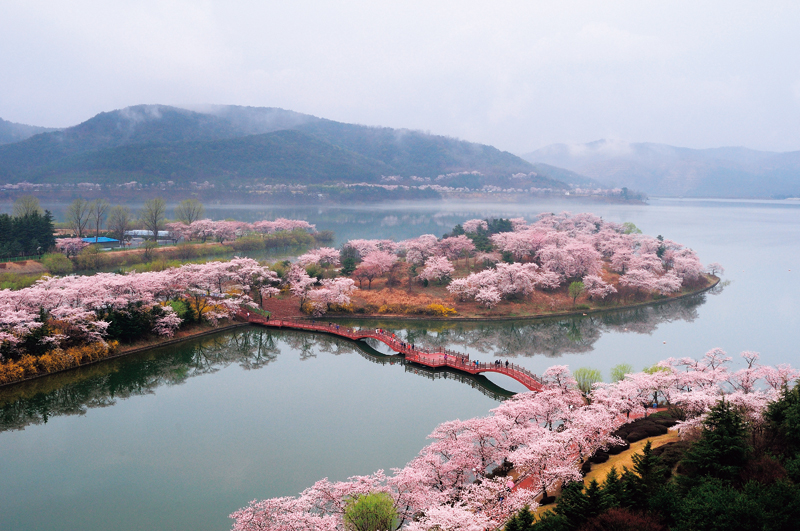
The Bomun Tourist Complex, established in the late 1970s, centers around the human-made Bomun Lake and spans approximately 7.9 square kilometers. This expansive resort features upscale hotels, recreational facilities, and art galleries, as well as streets lined with cherry trees that create a spectacular scene each spring when the blossoms dance in the wind.
© Gyeongju City, Photograph by Park Chun-yeop
HIDDEN COASTAL GEM
What some may not realize is that the Gyeongju area extends all the way to the sea. With most visitors planning their activities around historic inland sites, Gyeongju’s 30-kilometer coastline is often overlooked. It is a place steeped in legend. King Munmu (r. 661–681), who unified the three kingdoms of the Korean peninsula — Silla, Goguryeo, and Baekje — was buried under water two hundred meters from the shore and supposedly reincarnated as a dragon to protect Silla from invaders.
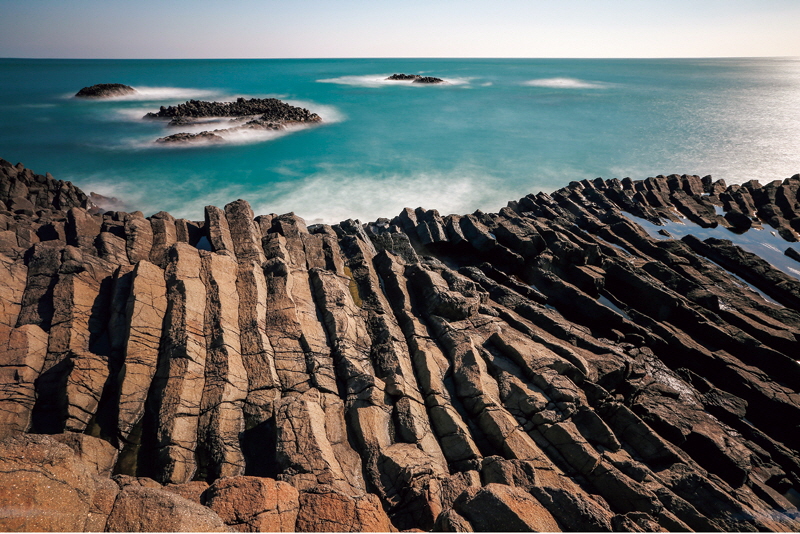
Jusangjeolli, columnar rock joints in Yangnam, Gyeongju, are particularly impressive in their scale and form. These remarkable stone columns, many exceeding 10 meters in length, extend across a 1.7-kilometer area and are found in diverse formations that resemble pleated skirts, fan shapes, and flower buds.
© Gyeongju City, Photograph by Lee Jeong-hui
Most parts of the coastline are connected by a trekking course, with the highlight being a 1.7-kilometer stretch named Padosori-gil, meaning “the road of the sound of the waves.” Located in an area where public access was long denied, this section was finally opened in 2012, allowing visitors to see Gyeongju’s hidden gem — jusangjeolli, the columnar rock joints in Yangnam, a national geopark, which were designated as a Natural Monument the same year.
The remarkable rock joints, most of them pentagonal or hexagonal in shape, were produced when flowing lava collided with seawater and cooled rapidly. Those in Yangnam formed around twenty million years ago, during the Tertiary Period of the Cenozoic Era. Nature stacked the stone pillars as neatly as matchsticks into various formations reminiscent of fans, pleated skirts, and flower buds. Waves endlessly crash against these natural structures, creating an arresting spectacle of white foam.
ANCIENT VILLAGE OF TWO CLANS
Yangdong Village, situated among low hills and valleys at the northern edge of Gyeongju, was designated as a UNESCO World Heritage site along with Hahoe Village in Andong. Two clans — the Son clan from Gyeongju and the Yi clan from Yeogang — began settling here in the 15th century and have never ventured elsewhere. Their uninterrupted presence, spanning nearly six hundred years, contrasts sharply with urban migration in the modern era. The village provides a glimpse into the wisdom the Korean people have shown in preserving traditional culture while living in harmony with nature.
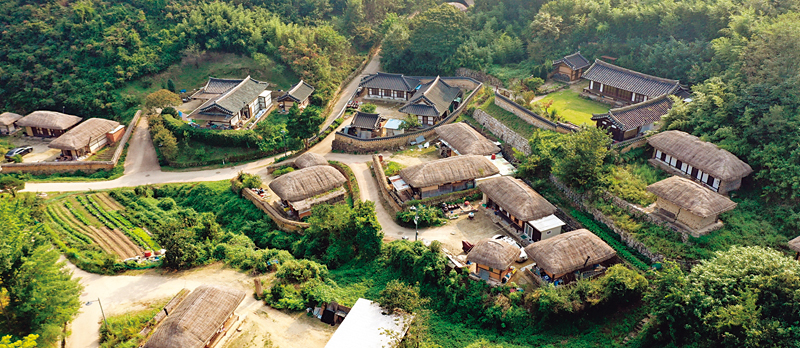
Yangdong Village in Gyeongju is a historic settlement established during the early Joseon Dynasty by two prominent families: the Son clan from Wolseong and the Yi clan from Yeogang. They have continuously inhabited the village for generations, maintaining an unbroken lineage. The oldest clan village in Korea, Yangdong has been designated as a national heritage site due to its residents’ preservation of traditional Confucian customs and practices.
© Gyeongju City
First-time visitors marvel at the layered landscape formed by houses standing along hills and valleys. Since they were built without disturbing the natural topography, no two dwellings sit at the same elevation. Such deliberate compromise with the land ensures that every home is bathed in sunlight and looks out on mountains through its windows. Walking up the hillside paths, visitors encounter a range of historic houses, each with a unique structure and design.
In Yangdong Village, four hanok (traditional tile-roofed houses) from the early Joseon period (1392–1910) remain, along with several trees that have provided shade to villagers for more than five hundred years. Walking down the path that crosses the hills into the lower valleys, other houses beckon visitors.
From the highest point in the village there are beautiful views of the vast plains and the surrounding mountains, together with the Hyeongsan River’s tributaries flowing through Gyeongju. Spread below is the peaceful vista of tiled and thatched roofs forming a rhythmic patchwork. There is nothing to block the views or disturb one’s peace of mind. Standing here, one cannot but realize that humans are also part of nature.
Gyeongju’s serene and beautiful landscapes, together with its rich cultural heritage, make it a truly extraordinary place. Throughout the four seasons, the city’s changing scenery offers travelers unforgettable moments.